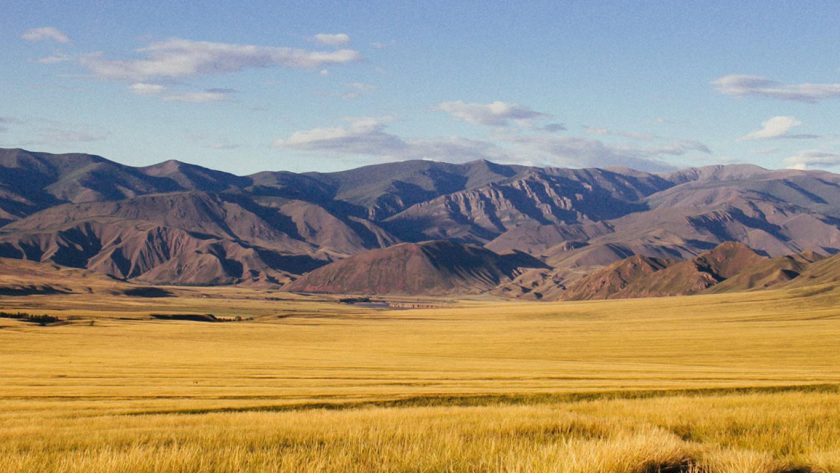Passing the Torch
Nestled in southeast Russia near the border of Mongolia and protected by the Sayan mountain range is the mysteriously rugged republic of Tuva. A country that once enjoyed brief independence, Tuva fell under Soviet control in 1944 and has since developed a distinct mixture of Mongolian, Russian, and ancient Tuvan culture. And thanks to an invitation from American Christian missionaries, the capital city of Kyzyl was to be my home for the summer. Upon arrival, I immediately fell in love with it.
The mighty Yenisei River snakes through the landscape, separating Kyzyl from the foothills of the Sayans. The shores of the Yenisei are lined with fly fishermen hoping for a lucky catch to bring home, and children splashing in the cold water. Situated on a concrete platform overlooking the churning river, Kyzyl boasts a monument marking the traditional center of Asia. According to legend, an explorer named Proctor erected a wooden monument in the 19th century to mark the estimated center of the continent, celebrating Kyzyl as the farthest point on earth from any ocean. Crumbling with age, the wooden monument was later replaced by the stone obelisk sculpture that still stands today. Across the river, the Sayan peaks loom in the distance like phantoms, invisible in the morning mists but stark by late afternoon, then vanishing again at sunset. As I watched the sun sink behind the mountains, I felt profoundly at peace.
My agenda for the summer was a “Pass the Torch” effort to help the resident American missionaries teach their young Tuvan church members how to get involved in local humanitarian efforts. Walking into the tiny, one–room church I felt a dozen pairs of eyes turn curiously toward me. With the help of my interpreter, I introduced myself and explained why I had made the journey, reassured by the warm smiles and eager nods I received. Their brown, almond–shaped eyes flashed with excitement as we discussed the plans for the summer. Over the next few days, I laid the foundations of friendship with the Tuvan teenagers and taught the dramas and songs that would later be used in our outreach endeavors.
Finally, the day came to leave Myskie Chetyre Tserkov, or “Church on Myskie Street No. 4,” and set out for our first experience in a volunteer effort. Across town stood a tiny orphanage that housed 92 children who eagerly awaited our arrival–as well as the gifts we were rumored to be bringing. I felt like Santa’s little helper walking into the room toting a sack bursting with toys. The children, normally playing with a half–inflated ball or an old doll with an arm missing from its socket, didn’t know what to do at first. I was suddenly surrounded by curious smiles, then outstretched arms and eager hands. The toys disappeared faster than our group could hand them out. Empty, the bag dropped to the ground, and I looked around. Before I had the chance to pat myself on the back, I saw something that humbled me. Off in the corner, one girl sat empty–handed, hunched over and quiet. From across the room, a little friend spotted her and, without a thought, walked over and gave away her only possession, a brand–new blonde–headed doll. That experience shaped the way our group approached the rest of our volunteer work: We were there simply to tend to the needs of others.
A week later, led by the missionaries, our small church group bumped along a ruined road, enduring a five–hour drive to the village of Abakon. Once known for its prosperous asbestos production, the town all but disintegrated after the Russian government closed the factories for fear of contamination. Here, we were to deliver supplies to a local hospital and visit the patients, mostly children, who had been afflicted with tuberculosis. After handing the doctors boxes of penicillin, syringes, and various drugs sent from colleagues in the U.S., we were encouraged to perform a small drama or two for the children to cheer them. Gathering outdoors–Tuvans believe being out in nature is the best way to be cured–our group began the comical skits I had taught them when I arrived. The drama as depicted a young man who, while waiting for a bus, seemed to catch every unusual disease–hiccups, crazy dance, spontaneous singing–that he came in contact with. The final character entered as a woman in labor, causing the poor man to run through the watching crowd hollering in fear. Laughter echoed through the trees and real sickness was easy to forget for a moment. After our performances of dance and song, we sat with the children to talk, laugh, or simply hug.
Tuvans, though very shy and soft–spoken, are deeply committed to spirituality. A majority of the population follows Shamanism, a belief in the universal unity of man and nature, lending to the belief that the sick, as well as the very young, should have daily outings to bring them closer to nature. Many Tuvan songs are derived from their Shamanistic beliefs, including the Khoomei, or throat–singing technique, which is a defining characteristic of the culture because it intertwines stories of Tuvan history with their understanding of the spirit world. Coming face to face with this ancient culture one rainy afternoon, I found myself seated in the yurt of some nomadic herdsmen who heard of my presence in Kyzyl, sipping yak’s milk and hearing the proud history of the family. A swapping of folk songs and stories became a staple during the summer months as I strove to connect with the people of this foreign land. Despite cultural differences, I left feeling welcomed into the lives of people who, before that summer, were unknown to me.
Most of the volunteer efforts during my summer were geared toward children. Orphanages abound in Tuva, a reflection of economic hardships believed to have started with the Soviet occupation. Our outreach group visited a number of them on a weekly basis to deliver food and spend time with those who were nearly forgotten. Monotony can lead to hopelessness in such places. Throughout the summer we did all we could to bring laughter and joy to the children. We introduced games such as duck, duck, goose, renamed “utka, utka, gowse,” which became a favorite among the orphans. We also taught the facility workers how to lead the children in planting little gardens, which served not only as a food source but also as a way to help the children learn the importance of working together to make things grow.
By the end of the summer, green stalks were poking out of the ground promising a future harvest of peas, tomatoes, and carrots. The orphaned children all became proud little gardeners as they watched the seeds they had carefully scattered begin to grow. Growing as well were the members of the youth group, who had given up one day a week to help others. Following each outreach, I would, through my helpful interpreter, sit with the group and discuss what we had encountered and how it affected us. My goal was to encourage the efforts to continue long after the surprisingly warm Siberian summer disappeared. Eldoni, a young girl whose blonde hair and outspoken nature seemed to disguise her Tuvan roots, eagerly spoke up at our last meeting and proclaimed the summer a success. She pledged to continue visiting the orphaned children she had been unaware of before. Many in the group echoed her sentiments, having learned to reconcile the reality of hardships within their own country with their longing to help. I knew then that the torch of volunteerism had truly been passed and these Tuvan youth would always be involved in the support and aid of others.



